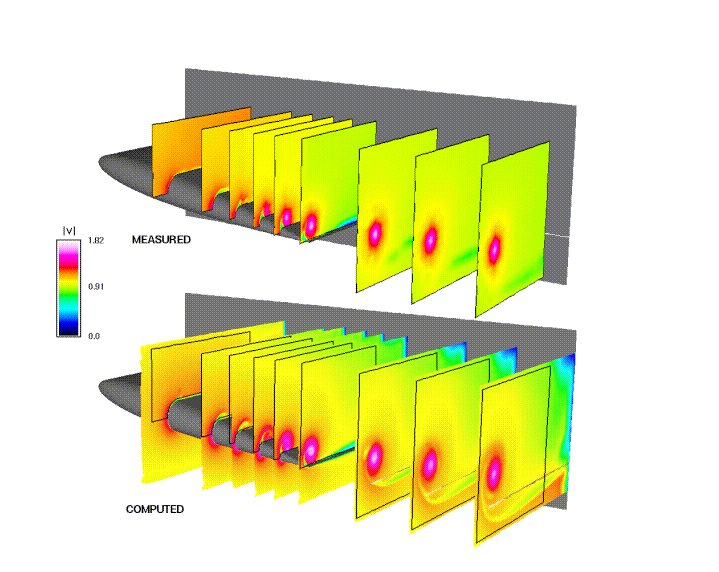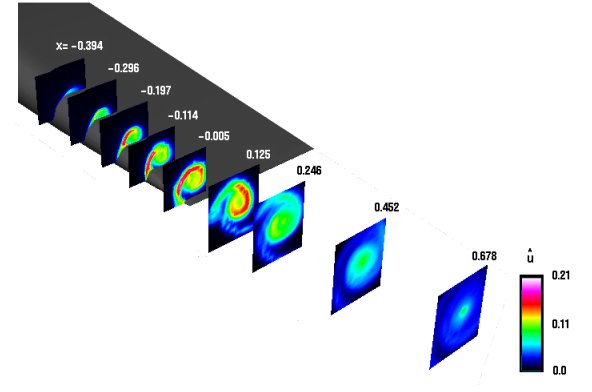
 |
Langley Research Center
Turbulence Modeling Resource
|
Exp: Flow Behind a NACA 0012 Wingtip
Return to: Data from Experiments - Intro Page
Return to: Turbulence Modeling Resource Home Page
The data on this page were provided by
Greg Zilliac.
These experimental data are for flow behind a NACA
0012 wing at angle-off-attack of 10 deg, with a focus on the wingtip vortex.
A main objective of the tests was to characterize the flowfield by measurement of both the complete mean
flowfield and Reynolds stress tensor.
The data were taken at NASA Ames, as described in the references.


Documentation for the experiment can be found in:
- Chow, J.S., Zilliac, G.G. and Bradshaw, P. "Mean and Turbulence Measurements in the Near Field of a Wingtip Vortex," AIAA J., Vol. 35, No. 10, 1997,
https://doi.org/10.2514/2.1.
- Chow, J.S., Zilliac, G.G., and Bradshaw, P., "Turbulence Measurements in the Near Field of a Wingtip Vortex," NASA TM 110418, February 1997,
https://ntrs.nasa.gov/citations/19970011348.
- Dacles-Mariani, J., Zilliac, G., Chow, J. and Bradshaw, P. "A Numerical/Experimental Study of a Wingtip Vortex in the Near Field," AIAA J., Vol. 33, No. 9, Sept 1995,
https://doi.org/10.2514/3.12826.
- Dacles-Mariani, J., Kwak, D. and Zilliac, G.G. "On Numerical Errors and Turbulence Modelling in Tip Vortex Flow Prediction," International Journal for Numerical Methods in Fluids, Vol. 30, pp. 65-82, 1999,
https://doi.org/10.1002/(SICI)1097-0363(19990515)30:1<65::AID-FLD839>3.0.CO;2-Y.
- Zilliac, G.G, "Skin Friction Distribution on a Wingtip," AIAA 98-0584, Reno, NV, Jan 1998,
https://doi.org/10.2514/6.1998-584.
- Dacles-Mariani, J., Kwak, D. and Zilliac, G., "Accuracy Assessment of a Wingtip Vortex Flowfield in the Near Field Region," AIAA 96-0208. Reno, NV, Jan 1996,
https://doi.org/10.2514/6.1996-208.
- Dacles-Mariani, J., D. Kwak, and Zilliac, G., "Incompressible Navier-Stokes Simulation Procedure for a Wingtip Vortex Flow Analysis," Presented at the Int'l. Symposium on Computational Fluid Dynamics, Sept 4-8, Lake Tahoe, NV, 1995.
- Chow, Jim S., Zilliac, Greg G., and Bradshaw, P., "Turbulence Measurements in the Near-Field of a Wingtip Vortex," Presented at the ASME Forum on Turbulence in Complex Flows, Chicago, IL, Nov 1994.
- Zilliac, G.G., Chow J.S., Dacles-Mariani, J., and Bradshaw, P., "Turbulent Structure of a Wingtip Vortex in the Near Field," AIAA 93-3011 AIAA Conference, Orlando, FL, June 1993,
https://doi.org/10.2514/6.1993-3011.
- Dacles-Mariani, J., Rogers, S., Kwak, D., Zilliac, G.G., and Chow, J.S., "A Computational Study of a Wingtip Vortex Flowfield," AIAA 93-3010 AIAA Conference, Orlando, FL, June 1993,
https://doi.org/10.2514/6.1993-3010.
- Chow, J.S., Zilliac, G.G., and Bradshaw, P., "Measurements in the Near-Field of a Turbulent Wingtip Vortex," AIAA 93-0551, AIAA Aerospace Sciences Meeting, Reno, NV, Jan 1993,
https://doi.org/10.2514/6.1993-551.
Some relevant information is given here, but the
interested reader is referred to the above publications and the data files for details:
- Wind tunnel test section: 48 inches wide by 32 inches high.
- Half-wing NACA 0012 model of 4 ft chord, 3 ft semispan, with rounded tip.
- Reynolds number based on chord = 4.6 million.
- Freestream velocity = 170 ft/s.
- Angle-of-attack = 10 deg.
- A trip fixed transition near the leading edge.
- Maximum freestream tunnel turbulence intensity level = 0.15%.
- The wing tip is the NACA 0012 profile rotated about it's symmetry axis.
The overall span (including the wingtip) is 36 inches measured from the wind tunnel wall to the furthest extent of the wing at the quarter chord
(chord is 48 inches). The wing's trailing edge thickness is 0.100 inches.

A tarred, gzipped file with the experimental data is provided here:
Thanks to John Schaefer of Boeing for providing the schematic of the geometry setup.
Return to: Data from Experiments - Intro Page
Return to: Turbulence Modeling Resource Home Page
Recent significant updates:
01/05/2021 - added note and schematic under relevant information regarding wing shape, including tip
Privacy Act Statement
Accessibility Statement
Responsible NASA Official:
Ethan Vogel
Page Curator:
Clark Pederson
Last Updated: 11/04/2021



